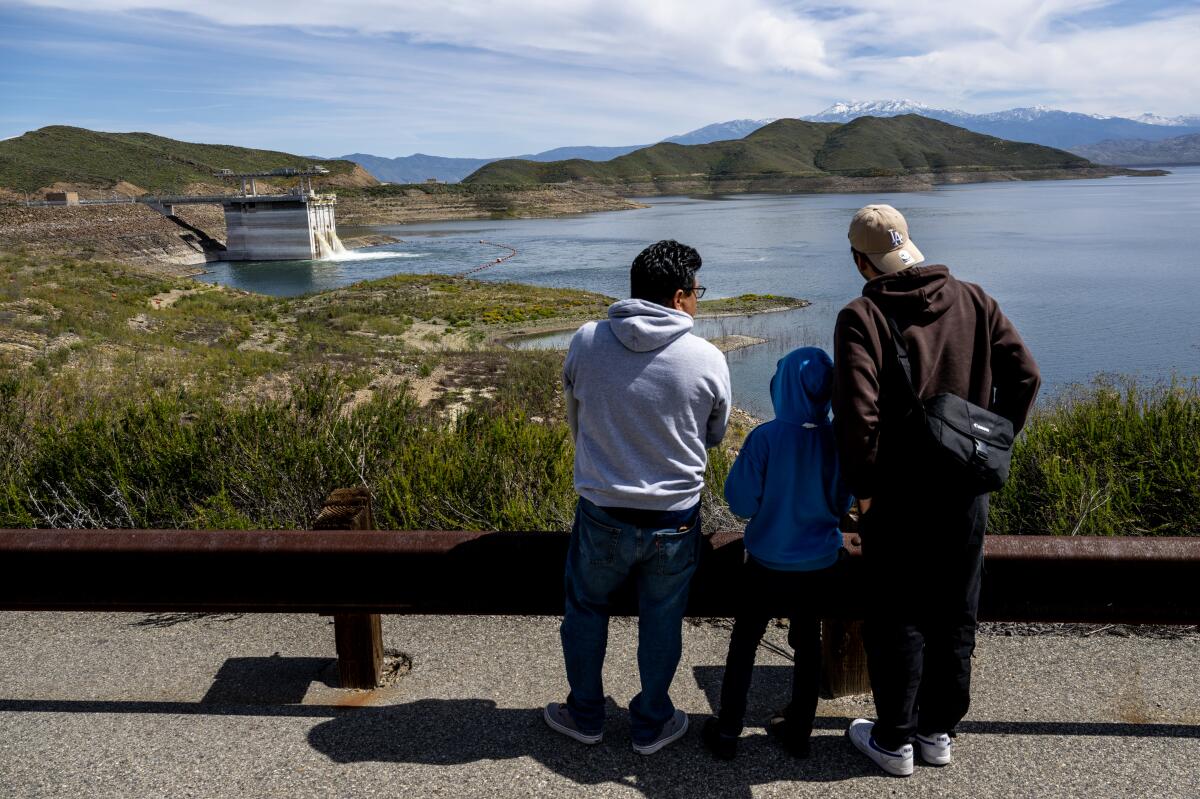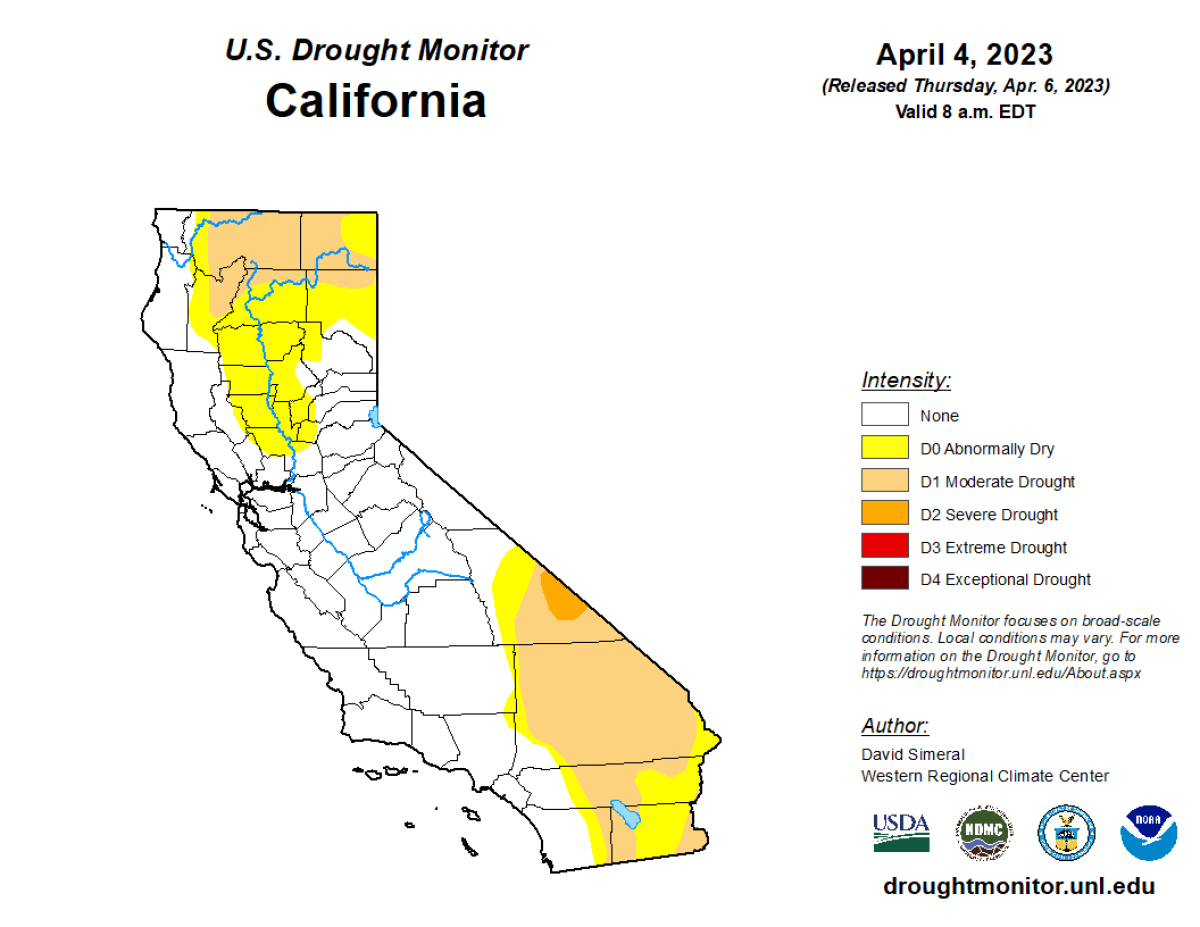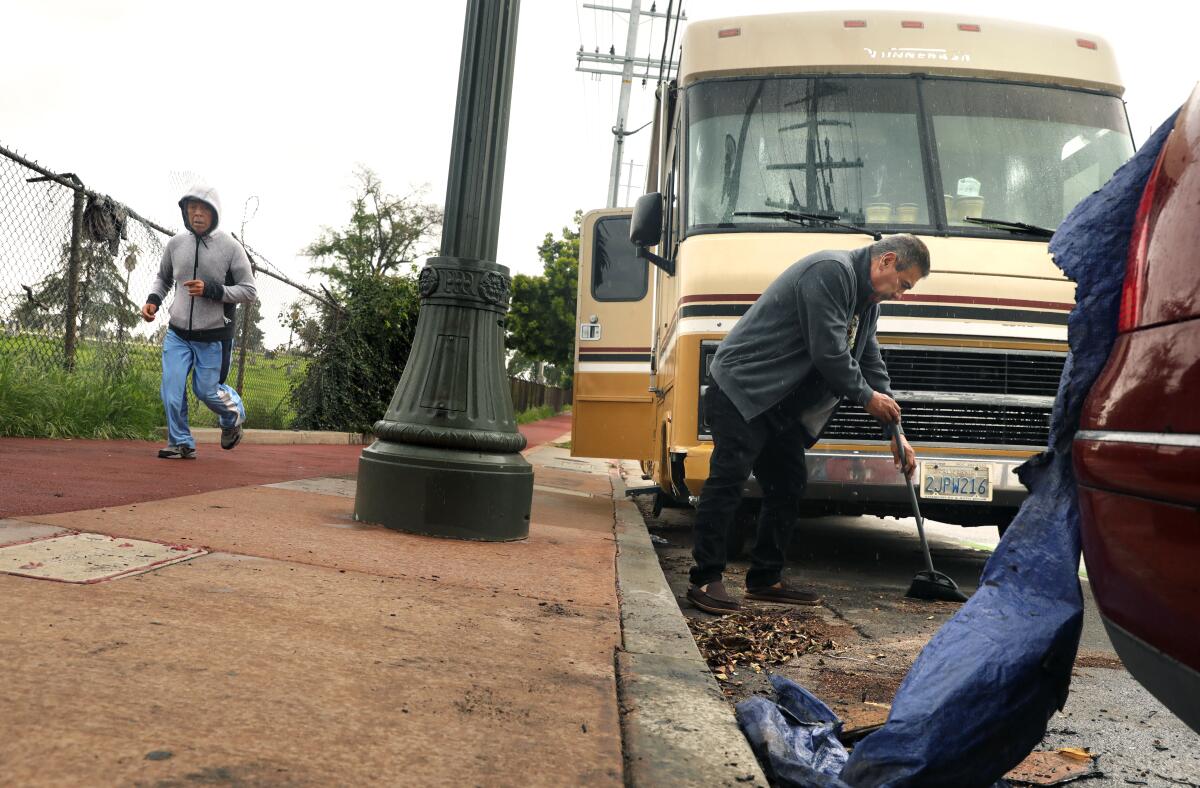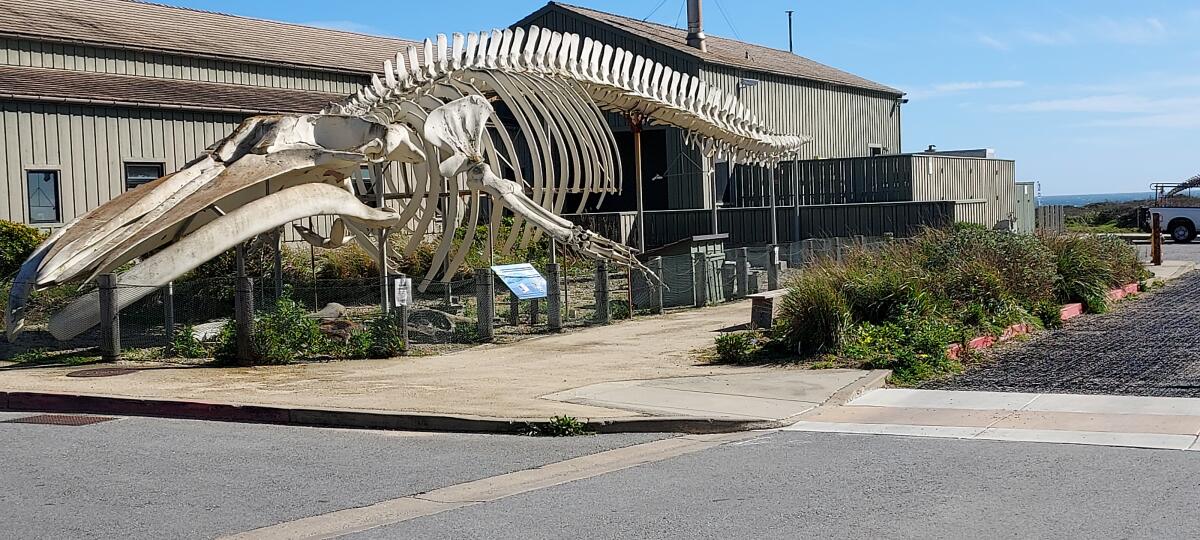California is between droughts right now. Will we act accordingly?

Good morning, and welcome to the Essential California newsletter. Itâs Wednesday, April 12.
You donât need me to tell you California got absolutely dumped on this winter, but Iâll try to summarize it anyway.
The stateâs snowpack currently contains roughly 30 million acre-feet of water â among the deepest itâs ever been.
From November through March, more than 27 inches of precipitation on average fell on California, marking the the eighth wettest rainy season in more than 125 years.
Thatâs more than 78 trillion gallons, as estimated by USA Today based on National Weather Service figures.
âI think the official estimate is âa hell of a lot,ââ joked hydroclimatologist Peter Gleick, co-founder and senior fellow of the Pacific Institute in Oakland. âMaybe the best way to summarize it is it was almost a record-breaking year for rain and snow.â
There have been plenty of headlines about the abnormally wet season putting an end to Californiaâs historic drought. Now, as we transition from wet season to dry season, water experts are answering an important question: Is the drought really over â and what does that mean for California?
For most of the state, the answer is technically yes. Our reservoirs show one facet of that recovery. As of April 4, Californiaâs reservoirs were filled to 73% capacity on average, slightly above the 30-year monthly average of 72% capacity.
The U.S. Drought Monitor map shows most of California in the clear, with the far north and southeastern parts of the state still considered abnormally dry or in moderate drought. (One area of Inyo County remains in severe drought.)

But for Gleick, thatâs the wrong question to be asking right now âbecause it sometimes sends the wrong message.â The state of Californiaâs water is much more complicated, he explained:
âThe Drought Monitor is mostly going to be free of red and orange and yellow colors. But our groundwater wonât have been recharged. Our wetlands wonât have fully recovered. Not every farmer is going to get all the water they want â even now.â
The word from climate scientists and water managers is that yes, the drought is over (mostly) â but keep using water like itâs not.
Conveying that message to the public is âthe biggest challenge I think weâre facing right now,â said Demetri Polyzos, resource planning team manager at the Metropolitan Water District of Southern California.
âPeople have drought message fatigue,â he said. âItâs like: âOh we have to continue to conserve? Itâs raining for heavenâs sake! Why canât we just move on from this?ââ
The MWD provides water to the most populous regions of Southern California, including portions of Ventura, Los Angeles, Orange, Riverside, San Bernardino and San Diego counties.
Polyzos said the âremarkable yearâ has changed the districtâs entire outlook on the upcoming dry season.
âThroughout the state, youâre seeing a lot of agencies taking... a breath,â he said. âInstead of worrying about where to find the water, now itâs a matter of where do we store all this water.â
For Gleick, the key question for California is what decision-makers do with that breathing room â âwhether weâre going to use that time to fix other parts of our water system or whether weâre going to forget that we have a water problem because we had a good year.â
He referenced a line from John Steinbeckâs âEast of Eden,â which reads:
âAnd it never failed that during the dry years the people forgot about the rich years, and during the wet years they lost all memory of the dry years. It was always that way.â
What should water agencies do with a good year?
For Polyzos, water officials are learning those lessons.
âIf you can point at or look at a silver lining in any of these extreme dry conditions, as painful as they are... we learn a lot about our system, our flexibility that we have existing,â he said. âWe learn a lot about our weaknesses.â
The goal now is to âresetâ the storage capacities that dwindled during the stateâs historic drought, he said, as well as continued messaging about water conversation.
âWet periods are actually the most difficult to manage through because we have more options in front of us, and we also have that potential concern that people will go back to their old ways,â Polyzos said. âBut weâve had a track record here in Southern California that folks are doing a great job in continuing to use water efficiently.â
A recent update to the MWDâs household water-use study found that outdoor water use was reduced between 2021 and 2022, while indoor use stayed mostly flat. Underserved communities made greater reductions in outdoor use.
According to Gleick, the key will be investing in programs to âimprove our ability to do the things we want with less water.â
That includes smarter irrigation systems, more water-efficient toilets, washing machines and dishwashers, reducing leaks in urban spaces, improving our wastewater recycling and â[getting] rid of our lawns.â
But is that happening? Could the state could prove Steinbeck wrong this time?
âIâm afraid Steinbeck was onto something,â Gleick told me, adding he was ânot happyâ with Gov. Gavin Newsomâs recent rollback of water restrictions. He explained:
âWe need to be accelerating and expanding conservation and efficiency policies. Itâs precisely in the wet years, when we have a little breathing room, that we ought to be doing more to prepare for the dry years that we know are increasingly frequent.â
What about our imported supplies?
The State Water Project is expected to deliver 75% of requested water supplies. Thatâs a notable jump from the 35% allocations announced in February.
Much of our water future is tied to the Colorado River, which supplies a considerable amount to the state each year.
This winterâs bountiful snowpack in the Rocky Mountains helped, but the river remains in crisis after decades of overuse.
And on Tuesday, federal officials presented two options for water allocation from the Colorado River, both of which represent major cuts to the supply.
Who is most at risk if we donât make progress?
Pablo Ortiz, a senior climate and water scientist at the Union of Concerned Scientists, said governments and water managers should be paying more attention to making agriculture â which accounts for the stateâs largest share of water use â more sustainable, along with modernizing the water infrastructure that controls when and how much of that water is delivered to farmlands.
Ortizâs work centers on how climate change is and will affect vulnerable communities, particularly farmworker communities in the San Joaquin Valley.
Ortiz said heâs âcautiously optimisticâ about Californiaâs water future, but canât ignore the decades of neglect that has affected farmworker communities.
He pointed to a 2022 state audit that showed nearly a million Californians lack access to safe drinking water. A large share of those communities are concentrated in the San Joaquin Valley region.
âFor a state like California, this should be completely unacceptable to have so many people that donât have this human right to water, even though it was established in California in 2012,â he said.
Rural communities that depend almost entirely on groundwater will continue to face inequities, he said, given that many of those aquifers arenât rebounding notably. And itâs both a quantity and quality issue, he explained, with nitrates, fertilizers and other contaminants making their way into water supplies that farmworkers and their families rely on.
âThey are the ones that bring food to our tables and they are often overlooked in many of these communities that had been impacted previously by the drought, now with all the flooding,â Ortiz said. âAnd they are going to be the first ones to feel the drought when it comes back.â
And now, hereâs whatâs happening across California:
Note: Some of the sites we link to may limit the number of stories you can access without subscribing.
L.A. STORIES
Some Boyle Heights residents are complaining about a line of RVs blocking a popular neighborhood jogging path, calling on the city to remove the large vehicles. Police say they have little recourse, while some RV dwellers say they try to be considerate. Los Angeles Times

The L.A. City Council voted Tuesday to reappoint Heather Hutt as interim replacement for Mark Ridley-Thomas, who was ousted from his seat last month after being convicted on federal corruption charges. Some critics call the move undemocratic, as residents of the cityâs 10th District will likely go more than three years without getting to elect their own representative. Los Angeles Times
L.A. police arrested a 43-year-old man on suspicion of defacing a mosque in Koreatown with anti-Islamic hate words this past Sunday. The incident is a recent example of a surge in hate crimes across the county, now at their highest level in nearly two decades. Los Angeles Times
Check out "The Times" podcast for essential news and more
These days, waking up to current events can be, well, daunting. If youâre seeking a more balanced news diet, âThe Timesâ podcast is for you. Gustavo Arellano, along with a diverse set of reporters from the award-winning L.A. Times newsroom, delivers the most interesting stories from the Los Angeles Times every Monday, Wednesday and Friday. Listen and subscribe wherever you get your podcasts.
POLITICS AND GOVERNMENT
An antisemitic groupâs hateful L.A. freeway stunt in October got the attention of Second Gentleman Doug Emhoff. The former L.A. resident and first Jewish spouse of a president or vice president has become an ambassador for his faith and heritage â and the White Houseâs voice against antisemitism. Los Angeles Times
That was fast â though not surprising. A state-backed loan program to help first-time California homebuyers ran out of money just 11 days after launching. A review of the data showed a disproportionate number of those who secured a shared equity loan were white, non-Latino residents in the Sacramento area. CalMatters
Democratsâ attempts to regain control of the U.S. House of Representatives in 2024 includes a big, California-shaped target. A super PAC tied to former House Speaker Nancy Pelosi has pledged to pour $35 million on competitive congressional races in the state â roughly triple what it spent in the 2022 midterms. Los Angeles Times
CRIME, COURTS AND POLICING
Isla Vistaâs massive Deltopia party draws thousands of local college students for a weekendlong beach-set, booze-soaked revelry. This year saw a surge in partygoers â and a surge of arrests and citations â despite attempts by the Santa Barbara County Sheriffâs Office to tamp down on the festivities. Los Angeles Times
City attorneys in San Francisco and San Diego say a California company is â[stirring] up fear amongst elderly homeownersâ across the nation and deceiving them to pay for protection against a problem that doesnât exist. The two cities are issuing a subpoena to Home Title Lock, which they accuse of selling âhome title theftâ protection. Attorneys argue incidents of title fraud are rare and that state law protects against it already. San Francisco Chronicle
Support our journalism
HEALTH AND THE ENVIRONMENT
Antibiotic-resistant superbugs have been found in L.A. Countyâs wastewater. That has scientists worried about regressing to a point where common infections and minor injuries are once again a death sentence. Los Angeles Times
Me: Californiaâs March was so cold.
You: How cold was it?
Me: Cold enough to rank the fifth-coldest March in 129 years of federal temperature data. The average temperature across the state was 44.2 degrees, according to NOAA. Los Angeles Times
Free online games
Get our free daily crossword puzzle, sudoku, word search and arcade games in our new game center at latimes.com/games.
AND FINALLY
Todayâs California landmark is from Dave Wade of Felton: Ms. Blue, a blue whale skeleton on display at UC Santa Cruz.

Dave writes:
Blue whales are the largest thing to have ever lived on earth. This one, dead from unknown causes, washed up on a beach in San Mateo County. The skeleton was saved and is on display at Long Marine Lab in Santa Cruz. You really canât believe how big it is without seeing it, and itâs a fun thing to share with visitors from out of town.
What are Californiaâs essential landmarks? Fill out this form to send us your photos of a special spot in California â natural or human-made. Tell us why itâs interesting and what makes it a symbol of life in the Golden State. Please be sure to include only photos taken directly by you. Your submission could be featured in a future edition of the newsletter.
Please let us know what we can do to make this newsletter more useful to you. Send comments to [email protected].
Sign up for Essential California
The most important California stories and recommendations in your inbox every morning.
You may occasionally receive promotional content from the Los Angeles Times.




